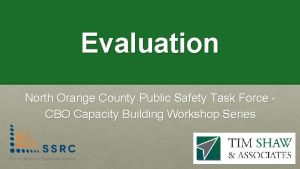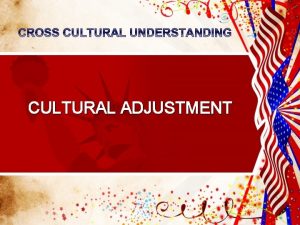Task Force on Data Presentation and Seasonal Adjustment



















- Slides: 19

Task Force on Data Presentation and Seasonal Adjustment Recommendations for the presentation of growth rates

Outline 1 Introduction 2 General Assumption 3 Recommendations – Rate of change with respect to previous period – Rate of change with respect to the same period of previous year – Annualised growth rates

1 Introduction • Task Force on Data Presentation and Seasonal Adjustment was set up 2 years ago • Last year: presentation of thoughts on the presentation of growth rates • Meeting at the beginning of this year • Today: Task Force recommendations

2 General Assumption Focus on presenting economic indicators to the general public

3 Recommendations • Motivation for the recommendations • Recommendations in detail

Rate of change with respect to previous period - motivation I • What is the general public interested in? • News = seasonally adjusted data = trend-cycle and irregular movements • To deal with irregular movements that blur the trend-cycle, the following rate of change can be used (Xt+Xt-1+Xt-2)/(Xt-3+Xt-4+Xt-5) 100 -100

Rate of change with respect to previous period - motivation II • An estimation of the trend-cycle can convey misleading information about the true current movement since they are usually estimated by extrapolating the underlying trend of the recent past. This is not in line with the presentation of news.

Rate of change with respect to previous period - recommend. I For rate of change with respect to previous period, seasonally adjusted data is the best way of presenting information about a time series (trend-cycle and irregular movements) and of presenting short-term developments, even if the irregular component is relatively large.

Rate of change with respect to previous period - recommend. II To deal with irregular movements that blur the trend, the “rate of change based on two or three month’s worth of values” can be utilised.

Rate of change with respect to previous period - recommend. III Percentage changes based on the trend-cycle component should be avoided if presenting current developments since the trend-cycle values at the current end of the series are usually estimated by extrapolating the underlying trend of the recent past and can therefore convey misleading information about the true current movement.

Rate of change with respect to previous period - recommend. IV Though seasonally adjusted time series are also revised over time, they reveal the cyclical movements at turning points sooner than raw or trend-cycle series do.

Rate of change with respect to the same period of previous year motivation I • Yo. Y very common in current practice of users and media • Warning I: Yo. Y can be misleading in assessing the cyclical movements of an indicator owing to the compounding of movements over a 12 -month period.

Rate of change with respect to the same period of previous year motivation II • Warning II: Base effects • Warning III: Trading-day effects

Rate of change with respect to the same period of previous year recommendation • For rate of change with respect to the same period of the previous year, the year-on-year changes should be applied to raw data and to data adjusted for calendar effects if the latter are available. Where necessary, special effects contained in the base period should be highlighted when presenting Yo. Y (base effect).

Rate of change with respect to the same period of previous year open question • Yo. Y based on seasonally adjusted data versus Yo. Y based on raw (or only tradingday adjusted) data – Common practice – Conflicting signals – Additional information

Annualised growth rates motivation I • Annualised growth rates help to answer the question of which annual percentage change would occur if the development established during the year were to continue unchanged. • Problems – Seasonal patterns – Trading-day influences – Irregular movements

Annualised growth rates recommendation I For annualised growth rates, data should only be annualised on the basis of seasonally adjusted and calendar adjusted time series which contain just minor irregularities. This means that annualising the growth rate of a single month can result in misleading signals.

Annualised growth rates recommendation II If special effects result in problems when annualising, the limited informative value of these annualised growth rates would have to be indicated separately.

Thank you for your attention
 Tiered task bias task
Tiered task bias task Why do globes lean sideways?
Why do globes lean sideways? S330 nwcg
S330 nwcg Expected enemy military symbol
Expected enemy military symbol Glencoe sustainability task force
Glencoe sustainability task force Samy tarazi
Samy tarazi Iowa food safety task force
Iowa food safety task force Fatf 40
Fatf 40 Green ribbon task force
Green ribbon task force Princeton policy task force
Princeton policy task force Desktop management task force
Desktop management task force Anchor institutions task force
Anchor institutions task force Global harmonisation task force
Global harmonisation task force Social performance task force
Social performance task force Marketing task force
Marketing task force Combined joint task force horn of africa
Combined joint task force horn of africa North orange county public safety task force
North orange county public safety task force Ctfphc
Ctfphc Military classes of supply
Military classes of supply Iowa food protection task force
Iowa food protection task force





































